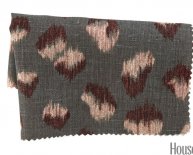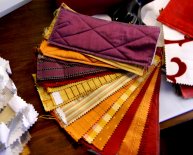
Printing Paste
This first entry is reproduced from the book 'Woodblock Printing' by F. Morley Fletcher, published by John Hogg, London 1916. (pp.58-60)
A paste must be used with the colour in order to hold it on to the surface of the paper and to give brilliancy. The colour, if printed without paste, would dry to powder again. The paste also preserves the matt quality which is characteristic of the Japanese prints.
Finely ground rice flour may be obtained from grocery dealers. An excellent French preparation of rice sold in packets as Creme de Riz is perfect for the purpose of making paste for printing. It should be carefully made as follows:
While half a pint of water is put to boil in a saucepan over a small spirit lamp or gas burner, mix in a cup about two teaspoonfuls of rice flour with water, added little by little until a smooth cream is made with no lumps in it. A bone spoon is good for this purpose. Pour this mixture into the boiling water in the saucepan all at once, and stir well till it boils again, after which it should be left simmering over a small flame for five minutes.
When the paste has cooled it should be smooth and almost fluid enough to pour: not stiff like a pudding.
While printing, a little paste is put out in a saucer and repleninshed from time to time.
Fresh paste should be made every day.
This next entry is reproduced from the book The Technique of the Color Wood-cut, by Walter J. Phillips, published by Brown-Robertson Co. Inc., New York 1926. [Editor's note: Phillips' entire text is available, courtesy of Mr. Roger Boulet]
The medium or binder is paste, made with starch, flour or rice. The first is most easily made, but its adhesive properties are apt to injure the surface of the paper if too much is used. Rice paste does no harm in that way.
To make starch paste, mix dry starch with enough cold water to make a stiff cream. (A teaspoonful of starch makes a cup of paste). Add boiling water, stirring the while, until the liquid thickens. If it does not thicken, boil it.
For printing add water after the thickening occurs, until you have a liquid of the consistency of milk, because further coagulation takes place when the paste cools. Rice flour or powder should always be boiled with water.
The next entry is reproduced from the book Japanese Woodblock Printing, by Hiroshi Yoshida, published by Sanseido, Tokyo 1939. (pp. 49) [Note: Yoshida's entire text is available
Paste
Paste is made from rice flour. Fine rice flour is kept in water over night, and with a suitable amount of water it is heated over a slow fire; it needs continuous stirring until it begins to boil. When cooked it finally turns translucent, but just before it turns entirely translucent, while there still remain some whitish parts, it should be taken off the fire. That is the stage in which the starch paste is the strongest. When it becomes too thick it can be diluted with water to a suitable consistency just before using. It should be sufficiently fluid so that it can be poured into another vessel, and when an amount less than the tip of the thumb will adhere to the end of a stick.
For printing a mino size (14 5/8 x 9 7/8 in.) block in tsubushi the amount of paste required will be less in volume than an inch of an ordinary cigarette.
Paste has a tendency to contract the paper, and it is best not to use too much of it. Rather it should be used in small quantity each time the impression is made. If on the one hand, a strong adherence of pigment is not required, only a tiny bit of it will be sufficient.
The starch paste gives a thickness to the pigment which will force it into paper when pressed in printing. It also helps in printing, for the paper sticks to the block better, thus keeping it secure on the block when the back of the paper is rubbed with the baren in printing.
When paste is mixed with pigment, the print shows a clear, uniform, deep colouring. Without it, the colour on the print is likely to give a porous effect, a dry, granular texture, known as goma (sesame). As long as the colour in the brush is sufficient, the starch paste is not added. It is added only when fresh pigment is put on the brush or on the block.
The next entry is reproduced from the book Japanese Print-making, by Toshi Yoshida & Rei Yuki, published by Tuttle, Tokyo 1966. (pp 55-56)
Paste is the basis of color and must be mixed on the block with the pigment by use of a brush. The process must be done only just before printing, and not previously. This gives substantial body to the pigment and thus secures its uniform application to the block. It should be noted that this procedure is not for the purpose of making the pigment adhere to the paper. If too much paste is used, the paper will stick to the block and cannot be removed.

















